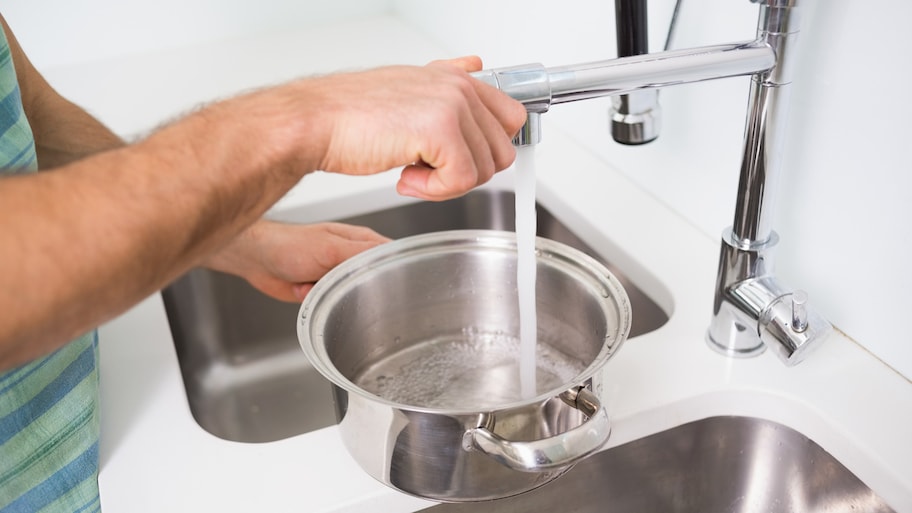How to Tell if You Have Lead Pipes in Your Home
If you have an older home, checking for lead is an important safety measure


Highlights
The EPA has limited the amount of lead in pipes since the 1980s.
A lead test can help determine if your home's water pipes contain lead.
Running the water prior to using a faucet or installing a water filter can reduce exposure to lead.
Replacing your lead pipes may be the way to go.
Few things are more important in our homes than the water flowing through the pipes. This water is what we drink, bathe with, and cook with, so if there is a risk of lead contamination, it is important to find out and tackle the problem immediately. As it turns out, copper and lead pipes can contain lead, especially if your home is more than a few decades old. Here is how to tell if you have lead pipes.
When Was Lead Used in Pipes?
In 1978, the Environmental Protection Agency (EPA) banned the use of lead in paint and varnish. Before the EPA issued this ban, lead was considered a low-risk metal, but the EPA’s decision exposed the perils of lead and had many people questioning what type of metal their pipes were.
In 1986, the EPA limited just how much lead could be present in plumbing pipes to control exposure via the Lead and Copper Rule. The rule has since gone through several revisions to determine when people need to take reparative action and how they must notify and protect the community from harmful levels of lead.
In short, if you have copper pipes, you should have a professional test for copper and lead in the water. If your home has an older plumbing system and fixtures, consider doing an inspection.
What Do Lead Pipes Look Like?
Lead pipes are typically gray in color. They are usually dull or matte, rather than shiny; however, if you scratch a lead pipe with a screwdriver or knife, the scratched area will shine like silver. Along with being dull gray, some lead pipes will also have white marks from oxidation.
How to Check Your Pipes for Lead
According to the EPA, homes built before 1986 are more likely to have pipes that contain lead than newer homes. If you are concerned, hire a local plumbing professional to come and inspect the pipes and conduct a test.
A quick DIY test can also determine what your pipes are made of. Even with this “gut check” test, make sure to have a pro follow up with a more thorough inspection, especially if you have any concerns or questions.
Find the water service line that brings water into your home. It is usually in the basement near the water meter.
With a screwdriver, expose a small metal area by scraping away the top layer of paint (if needed) to test. Try to expose an area near where it enters the home or close to the meter.
If the scraped area reveals shiny silver, it is likely lead.
To confirm, place a magnet on the surface; lead is not magnetic.
If the scraped area is copper, magnets still will not stick.
If the scraped area stays a dullish gray, it is likely a galvanized steel pipe.
Finally, test the solder (binding between pipes) using the same method, as copper and brass pipes can still have lead solders. If the scraped area is shiny, the solder likely contains lead.
Another option is to test the water in your home for lead. You provide a water sample to a lab for testing, which can cost anywhere from $15 to $100.
Other Sources of Lead in Drinking Water
A naturally occurring metal, lead was commonly used in piping before the EPA ban. Although you may think you are in the clear if your pipes are not lead, it was also used to solder copper and brass piping, so even older brass pipes and fixtures are at risk. This is because the ban included provisions that allowed lead use in certain fixtures such as shower valves and other non-drinking water taps—up to 0.25%. Even a brand new home may have fixtures which used lead in some part of the manufacturing, so a drinking water test is always a good idea.
Just how harmful lead can be depends on exposure levels. Even low lead exposure can be detrimental over time, especially in children, including stunted brain development, according to the Mayo Clinic. High levels of lead exposure can cause kidney and nervous system issues or, in extreme cases, death.
How to Reduce Exposure to Lead From Water

The EPA has issued several guidelines for helping you reduce the risk of lead exposure in pipes. If you suspect your pipes contain lead and cannot have them treated right away, try these tips:
If you have not used your faucet, let the water run until cold before drinking. This process should take under 30 seconds.
Only use cold water when possible, as the EPA has found that hot water contains higher amounts of lead.
Regularly test your water quality (contact your local water supplier for test kits).
Replace older pipes with new pipes made of synthetic material.
Consider installing a water filter on your kitchen faucet or using a pitcher with a filter. Be sure to choose a filter that is certified to remove lead.
Switch to drinking bottled water.
How Much Does It Cost to Replace Lead Pipes?
A new water main costs $1,570 on average to install though most homeowners pay between $610 and $2,570. Expect to spend anywhere from $50 to $250 per linear foot, depending on length, material, depth, and accessibility. You will also need a city permit, which varies in price from location to location. Consult your plumber with further permit questions.
You may also need to replace the fixtures in your sinks, including the faucets. The average cost to replace a bathroom faucet is $260. The cost of replacing a kitchen faucet is about the same. How much you pay will vary considerably based on the type and style of faucet you choose and your location. Whether you perform the installation yourself or hire a plumber will also affect the total cost.
Frequently Asked Questions
According to the EPA, there is no safe level of lead in the blood, and so the maximum contaminant level goal (MCLG) for lead in water is zero. Even at low levels, lead is harmful to human health. It can also remain in the body and build up over time with repeated exposure.
How you test for lead in your water depends on the source of your home's water supply. If you have municipal water, your local water system may offer to test the water for free or may connect you to a lab that will perform the testing.
If you have a private well that provides drinking water, you are responsible for testing it for lead. Look for a lab that is accredited by your state's Department of Environmental Protection to perform the test.
Several different measurements may be used to determine the amount of lead in water. The most common unit of measurement is micrograms per liter (µg/L), which is the same as parts per billion. Another measurement is milligrams per liter (mg/L), which is the same as parts per million.

